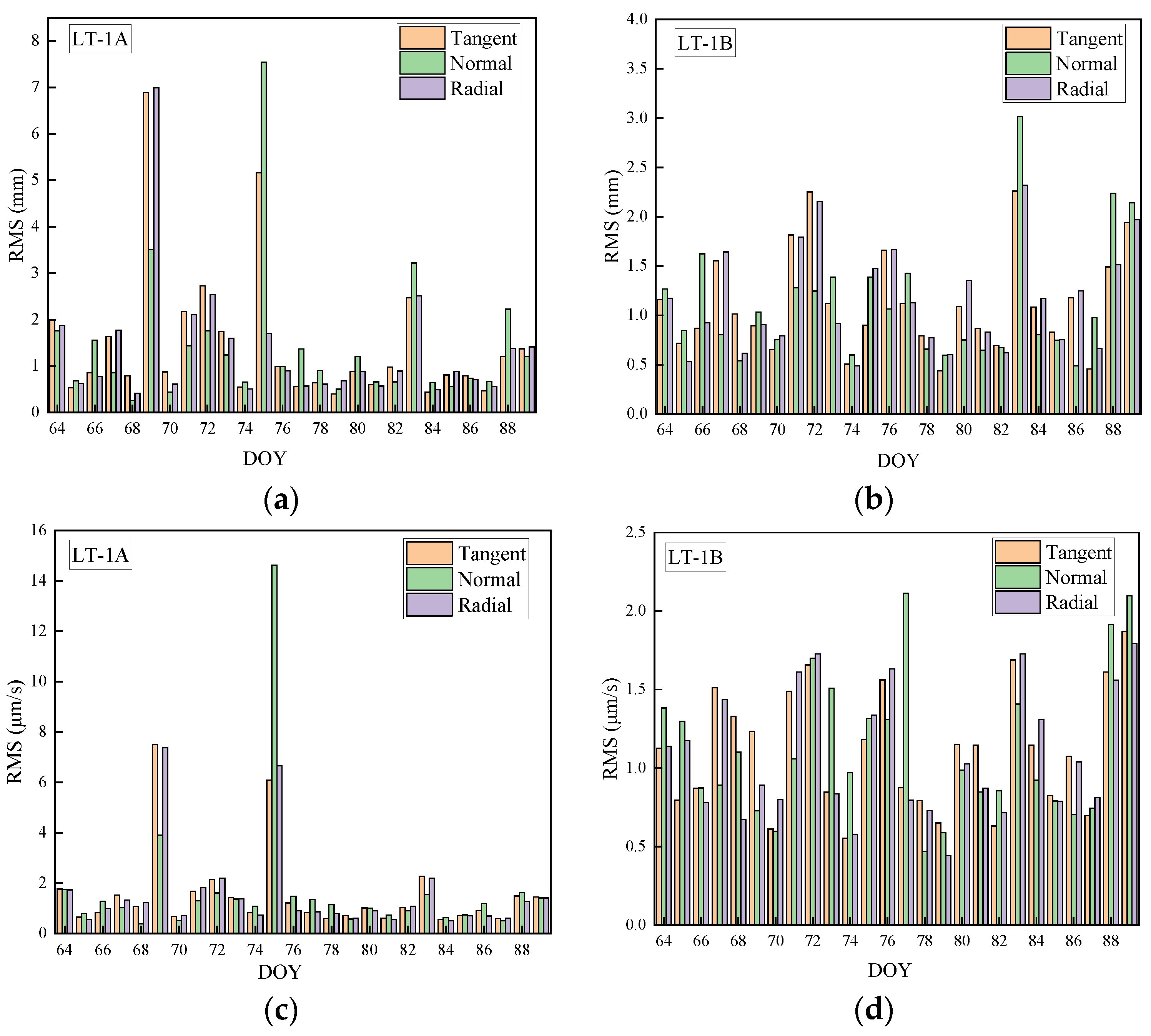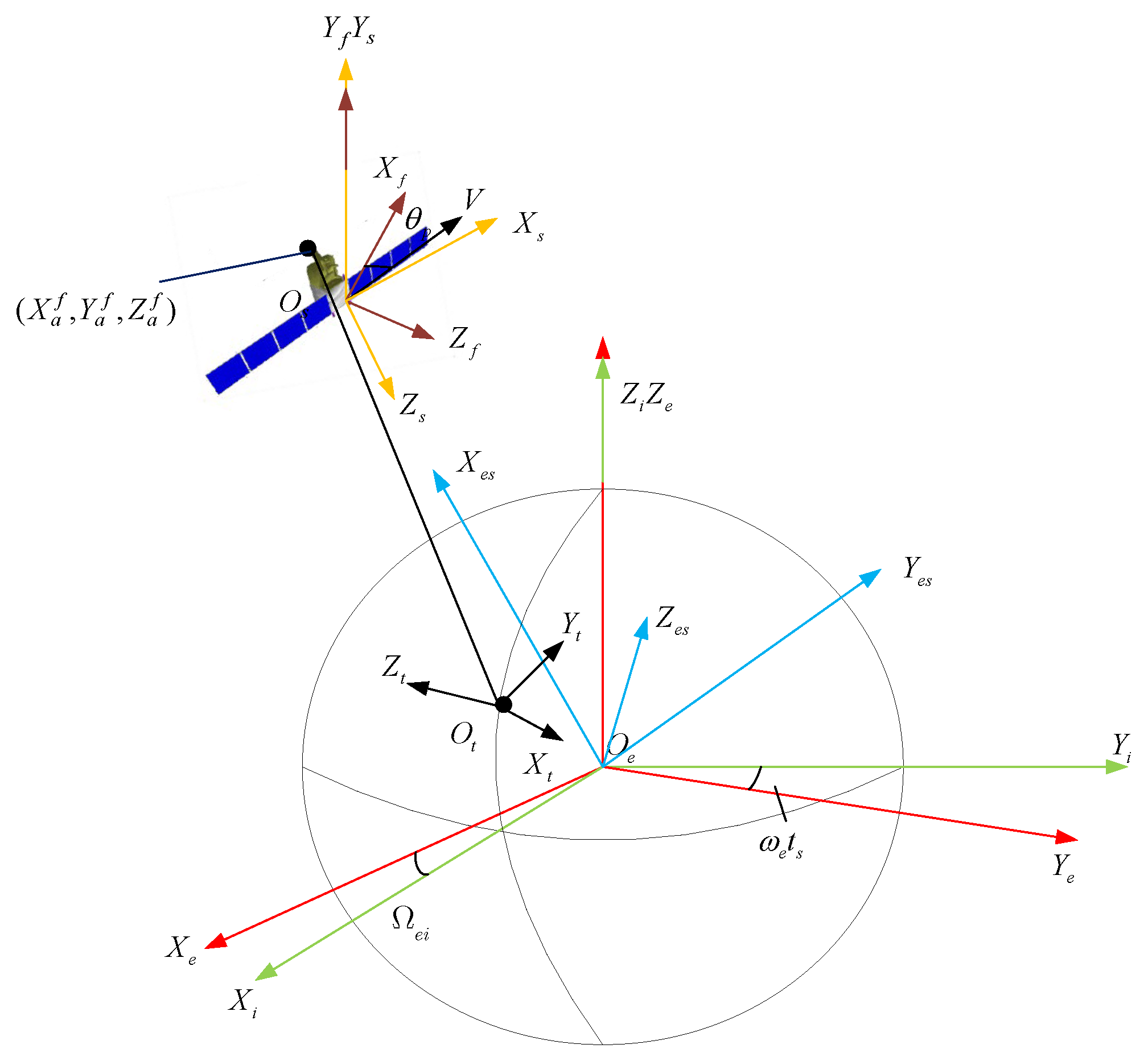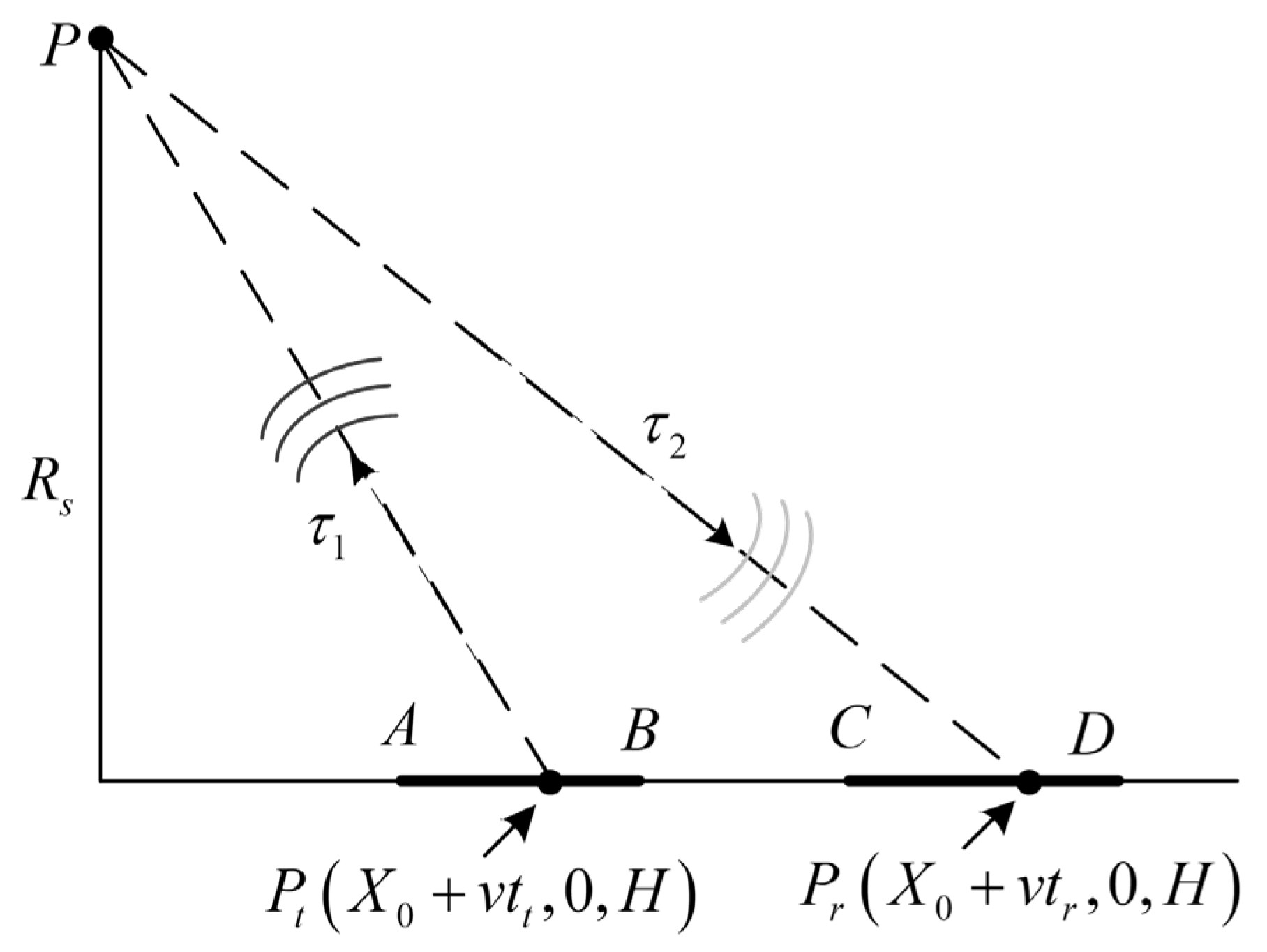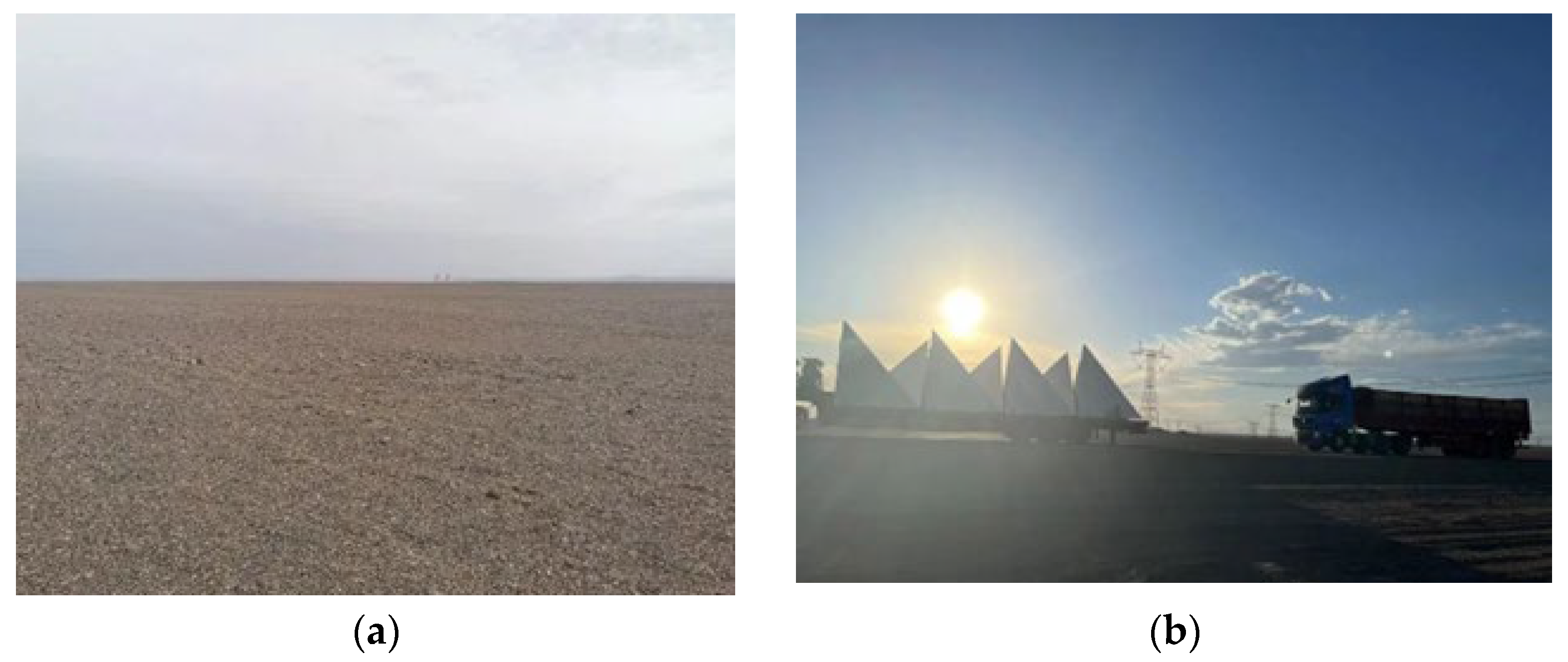Geometric Error Analysis and Correction of Long-Term In-Orbit Measured Calibration Data of the LuTan-1 SAR Satellite
Highlights
- The planar positioning accuracy of the LuTan-1 SAR satellite over three years of in-orbit data meets the in-orbit testing requirements and remains stable.
- A full-chain geometric error analysis and correction method has been established, improving the positioning accuracy of corrected images to better than 3.0 m.
- The accuracy and stability of LuTan-1 SAR satellite data provide critical support for its applications in fields such as deformation monitoring.
- The full-chain geometric error analysis and correction method has laid the research foundation for enhancing the geometric quality and application services of domestic SAR satellites.
Abstract
1. Introduction
2. Error Source Analysis of Full-Link Geometric Positioning
2.1. Error of the Antenna Phase Center
2.1.1. Satellite Position and Velocity Measurement Error
2.1.2. Antenna Phase Center Conversion Error
2.2. Measurement Error of Control Points
2.2.1. Measurement Error
2.2.2. The Geophysics Effect
2.3. Error of the SAR Payload
2.3.1. Error of System Time Delay
2.3.2. Time Error in Azimuth
2.3.3. Pulse Repetition Rate Error
2.4. Error of Atmospheric Delay
2.4.1. Error in the Troposphere
2.4.2. Ionospheric Error
2.5. Error of Image Processing
2.5.1. Error of the Go–Stop Model
2.5.2. Error of Elevation
3. Results and Discussion
3.1. Comparative Analysis of Test Index and Design Index
3.2. Analysis of Index Stability
3.3. Geometric Precision Correction Positioning Accuracy
4. Conclusions
- The image geometric positioning accuracy of the LT-1A and LT-1B satellites in orbit within three years meets the requirements of the index test, and the average geometric plane positioning accuracy is between 50 m and 90 m without geometric precision correction.
- The geometric positioning accuracy of the LT-1 satellite between the two satellites remained relatively stable from 2022 to 2024, and the planar positioning accuracy in 2023 was more stable compared to that in 2022 and 2024.
- After precise correction, the image positioning error can be reduced to about 2.1 m in range and 1.3 m in azimuth, and the geometric positioning accuracy is better than 3.0 m.
- Although this research yielded satisfactory test results for geometric positioning accuracy, there remains room for improvement. While the satellite’s planar positioning has achieved a high level of performance, the analysis of coupling effects among various errors and the seasonal trends in long-term image geometric positioning accuracy still requires further validation. With the increasing application of satellites, we will continue to conduct in-depth research in conjunction with calibration experiments, persistently address issues, and enhance satellite data processing and application services.
Author Contributions
Funding
Data Availability Statement
Acknowledgments
Conflicts of Interest
References
- Wiley, C.A. Synthetic Aperture Radar. IEEE Trans. 1985, 21, 440–443. [Google Scholar] [CrossRef]
- Deng, Y.; Zhao, F.; Wang, Y. Brief Analysis on the Development and Application of Spaceborne SAR. J. Radars 2012, 1, 1–10. [Google Scholar] [CrossRef]
- Zhang, Q.; Han, X.; Liu, J. Progress and development trend of space-borne synthetic aperture radar remote sensing. Spacecr. Eng. 2017, 26, 1–8. [Google Scholar]
- Jin, G.; Liu, K.; Liu, D. An Advanced Phase Synchronization Scheme for LT-1. IEEE Trans. Geosci. Remote Sens. 2019, 58, 1735–1746. [Google Scholar] [CrossRef]
- Deng, Y.; Wang, Y. Key technologies for spaceborne SAR payload of LuTan-1 satellite system. J. Geod. Geoinf. Sci. 2024, 53, 1881–1895. [Google Scholar]
- Jiao, Y.; Liu, K. The Synchronization Transceiver Design and Experimental Verification for the LuTan-1 SAR Satellite. Sensors 2020, 20, 1463. [Google Scholar] [CrossRef]
- Zhang, R.; Xiang, W.; Liu, G. Interferometric coherence and seasonal deformation characteristics analysis of saline soil based on Sentinel-1A time series imagery. J. Syst. Eng. Electron. 2021, 32, 1270–1283. [Google Scholar] [CrossRef]
- Liang, D.; Liu, K.; Zhang, H. A High-Accuracy Synchronization Phase-Compensation Method Based on Kalman Filter for Bistatic Synthetic Aperture Radar. IEEE Geosci. Remote Sens. Lett. 2020, 17, 1722–1726. [Google Scholar] [CrossRef]
- Chen, J.; Li, W. Recent progress and trend of foreign SAR satellites. Shanghai Aerosp. 2016, 33, 1–19. [Google Scholar]
- Lou, L.; Liu, Z.; Zhang, H. Design and implementation of TH-2 satellite project. J. Geod. Geoinf. Sci. 2020, 49, 1252–1264. [Google Scholar]
- Li, S.; Ye, Y.; Fan, W. Analysis on positioning accuracy of TH-2 satellite system. J. Geod. Geoinf. Sci. 2022, 51, 2481–2492. [Google Scholar]
- Mohr, J.J.; Madsen, S.N. Geometric calibration of ERS satellite SAR images. IEEE Trans. Geosci. Remote Sens. 2001, 39, 842–850. [Google Scholar] [CrossRef]
- Rosenqvist, A.; Shimada, M.; Ito, N. ALOS PALSAR: A Pathfinder Mission for Global-Scale Monitoring of the Environment. IEEE Trans. Geosci. Remote Sens. 2007, 45, 3307–3316. [Google Scholar] [CrossRef]
- Covello, F.; Battazza, F.; Coletta, A. COSMO-SkyMed an existing opportunity for observing the Earth. J. Geodyn. 2010, 49, 171–180. [Google Scholar] [CrossRef]
- Eineder, M.; Minet, C.; Steigenberger, P. Imaging Geodesy—Toward Centimeter-Level Ranging Accuracy with TerraSAR-X. IEEE Trans. Geosci. Remote Sens. 2011, 49, 661–671. [Google Scholar] [CrossRef]
- Zhang, R.; Jiang, X. System Design and In-orbit Verification of the HJ-1C SAR Satellite. J. Radars 2014, 3, 249–255. [Google Scholar] [CrossRef]
- Jiayin, L.; Xiaolan, Q.; Yuxin, H. Geolocation of HJ-1C Satellite Image Using One Gcp. In Proceedings of the 2014 IEEE Geoscience and Remote Sensing Symposium, Quebec City, QC, Canada, 13–18 July 2014; pp. 4458–5229. [Google Scholar]
- Ding, C.; Liu, J.; Lei, B. Preliminary Exploration of Systematic Geolocation Accuracy of GF-3 SAR Satellite System. J. Radars 2017, 6, 11–16. [Google Scholar]
- Lin, M.; Yuan, X.; Liu, J.; Ye, X.; Zhang, Q. Application of gf-3 satellite monitoring typhoon. Spacecr. Eng. 2017. [Google Scholar]
- Zhang, Q. General design and key technologies of GF-3 satellite. J. Geod. Geoinf. Sci. 2017, 46, 269–277. [Google Scholar]
- Deng, Y.; Yu, W.; Zhang, H. Development trend of future spaceborne SAR technology. J. Radars 2020, 9, 33. [Google Scholar]
- Dang, H.; Tan, X. Review of spaceborne microwave remote sensing technology. Space Electron. Technol. 2025, 22, 35–49. [Google Scholar]
- Li, J.; Tan, X.; Li, C.; You, D. A review of development of GEO SAR technology. Space Electron. Technol. 2025, 22, 11–27. [Google Scholar]
- Wang, X.; Qi, R.; Yao, X. High-precision Simulation of Dynamic Oceans Synthetic Aperture Radar Imaging and Its Typical Application. J. Radars 2025, 14, 712–734. [Google Scholar]
- Yoon, Y.T.; Eineder, M.; Yague-Martinez, N. TerraSAR-X Precise Trajectory Estimation and Quality Assessment. IEEE Trans. Geosci. Remote Sens. 2009, 47, 1859–1868. [Google Scholar] [CrossRef]
- Milbert, D. Solid Earth Tide, FORTRAN Computer Program. Available online: http://geodesyworld.github.io/SOFTS/solid.htm (accessed on 15 August 2025).
- Cao, Y.; Jonsson, S. Advanced Insar tropospheric corrections from global atmospheric models that incorporate spatial stochastic properties of the troposphere. J. Geophys. Res. Solid Earth 2021, 126, e2020JB020952. [Google Scholar] [CrossRef]
- Qiu, X.; Han, C.; Liu, J. A Method for Spaceborne SAR Geolocation Based on Continuously Moving Geometry. J. Radar 2013, 54–59. [Google Scholar] [CrossRef]















| Level | Point-to-Point Error | Mean Error in Baseline Components of Adjacent Points | ||
|---|---|---|---|---|
| Horizontal Component | Vertical Component | Horizontal Component | Vertical Component | |
| B | 5 mm | 10 mm | 5 mm | 10 mm |
| C | 10 mm | 15 mm | 10 mm | 20 mm |
| D | 15 mm | 30 mm | 20 mm | 40 mm |
| E | 15 mm | 30 mm | 20 mm | 40 mm |
| Effect | Level/mm | Vertical/mm |
|---|---|---|
| Earth tide | ±50.0 | ±200.0 |
| Ocean tide | ±10.0 | ±50.0 |
| Pole shift | ±1.5 | ±6.0 |
| Tidal load of the atmosphere | ±0.2 | ±1.5 |
| Load of the ocean polar tide | ±0.3 | ±0.5 |
| Non-tidal load of the atmosphere | ±3.0 | ±0.5 |
| Long-term trends | Up to 100 mm/year | Up to 15.0 mm/year |
| Year | Satellite | Collection Date | Number of Images | Region |
|---|---|---|---|---|
| 2022 | LT-1A | 27 April | 9 | Australia |
| 17 May | Australia | |||
| 27 May | Australia | |||
| 31 August | Hami, Xinjiang | |||
| 2 September | Hami, Xinjiang | |||
| 27 October | Hami, Xinjiang | |||
| LT-1B | 17 May | 9 | Australia | |
| 18 May | Australia | |||
| 31 August | Hami, Xinjiang | |||
| 23 September | Hami, Xinjiang | |||
| 27 October | Hami, Xinjiang |
| Year | Satellite | Collection Date | Number of Images | Region |
|---|---|---|---|---|
| 2023 | LT-1A | 17 October | 9 | Australia |
| 25 October | Australia | |||
| 6 November | Australia | |||
| 12 November | Sunit, Inner Mongolia | |||
| 2 December | Sunit, Inner Mongolia | |||
| 24 December | Sunit, Inner Mongolia | |||
| LT-1B | 16 October | 9 | Hami, Xinjiang | |
| 25 October | Hami, Xinjiang | |||
| 11 November | Hami, Xinjiang | |||
| 19 November | Sunit, Inner Mongolia | |||
| 3 December | Sunit, Inner Mongolia |
| Year | Satellite | Collection Date | Number of Images | Region |
|---|---|---|---|---|
| 2024 | LT-1A | 12 October | 9 | Hami, Xinjiang |
| 20 October | Sunit, Inner Mongolia | |||
| 28 October | Hami, Xinjiang | |||
| 11 November | Sunit, Inner Mongolia | |||
| 13 November | Sunit, Inner Mongolia | |||
| 17 November | Hami, Xinjiang | |||
| LT-1B | 12 October | 9 | Hami, Xinjiang | |
| 16 October | Sunit, Inner Mongolia | |||
| 20 October | Sunit, Inner Mongolia | |||
| 1 November | Hami, Xinjiang | |||
| 11 November | Sunit, Inner Mongolia |
| Satellite | LT-1A | LT-1B | ||||
|---|---|---|---|---|---|---|
| Time/year | 2022 | 2023 | 2024 | 2022 | 2023 | 2024 |
| Maximum/m | 134.06 | 97.93 | 129.19 | 128.64 | 86.02 | 104.12 |
| Minimum/m | 19.32 | 45.67 | 31.55 | 32.97 | 14.95 | 29.62 |
| Average/m | 86.08 | 69.42 | 80.57 | 57.25 | 60.83 | 69.54 |
Disclaimer/Publisher’s Note: The statements, opinions and data contained in all publications are solely those of the individual author(s) and contributor(s) and not of MDPI and/or the editor(s). MDPI and/or the editor(s) disclaim responsibility for any injury to people or property resulting from any ideas, methods, instructions or products referred to in the content. |
© 2025 by the authors. Licensee MDPI, Basel, Switzerland. This article is an open access article distributed under the terms and conditions of the Creative Commons Attribution (CC BY) license (https://creativecommons.org/licenses/by/4.0/).
Share and Cite
Liu, L.; Wang, A.; Zhang, M.; Han, Q.; Hou, M.; Li, Y. Geometric Error Analysis and Correction of Long-Term In-Orbit Measured Calibration Data of the LuTan-1 SAR Satellite. Remote Sens. 2025, 17, 3611. https://doi.org/10.3390/rs17213611
Liu L, Wang A, Zhang M, Han Q, Hou M, Li Y. Geometric Error Analysis and Correction of Long-Term In-Orbit Measured Calibration Data of the LuTan-1 SAR Satellite. Remote Sensing. 2025; 17(21):3611. https://doi.org/10.3390/rs17213611
Chicago/Turabian StyleLiu, Liyuan, Aichun Wang, Mingxia Zhang, Qijin Han, Minghui Hou, and Yanru Li. 2025. "Geometric Error Analysis and Correction of Long-Term In-Orbit Measured Calibration Data of the LuTan-1 SAR Satellite" Remote Sensing 17, no. 21: 3611. https://doi.org/10.3390/rs17213611
APA StyleLiu, L., Wang, A., Zhang, M., Han, Q., Hou, M., & Li, Y. (2025). Geometric Error Analysis and Correction of Long-Term In-Orbit Measured Calibration Data of the LuTan-1 SAR Satellite. Remote Sensing, 17(21), 3611. https://doi.org/10.3390/rs17213611





